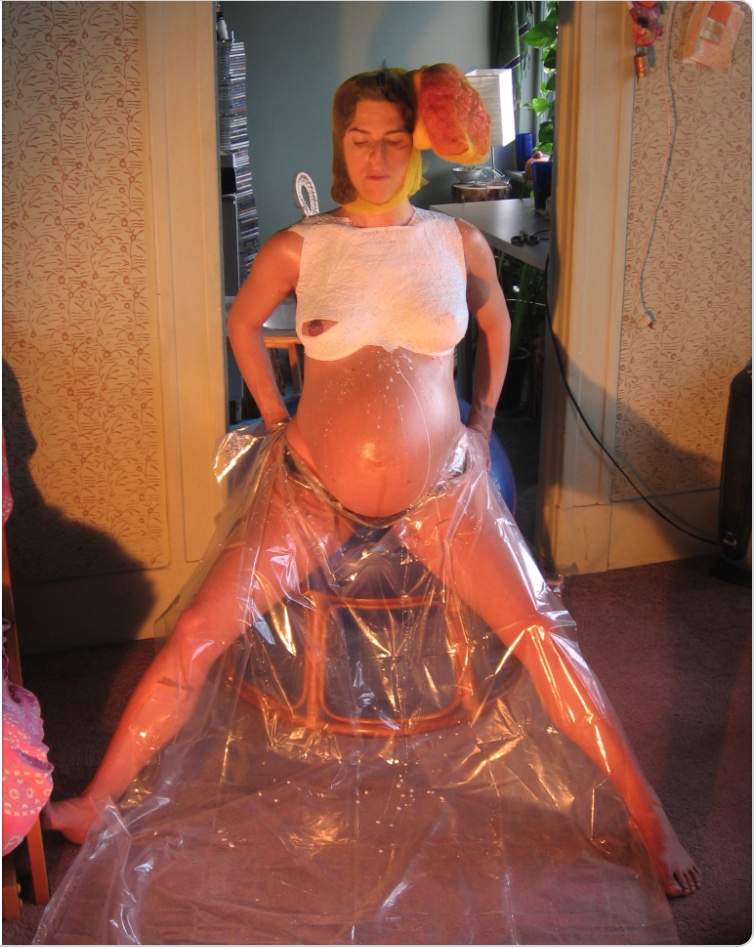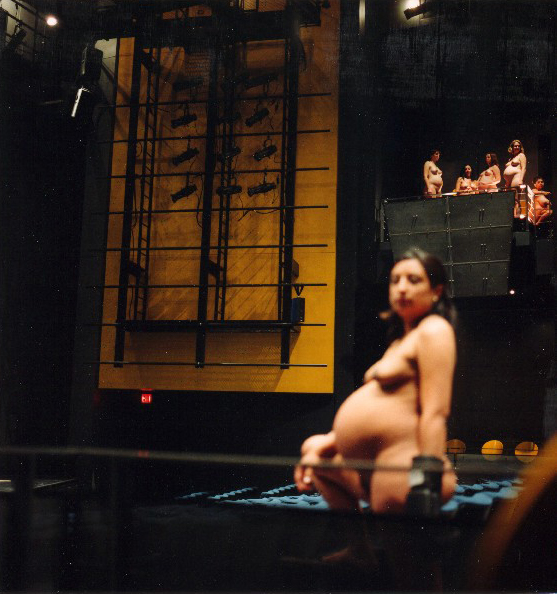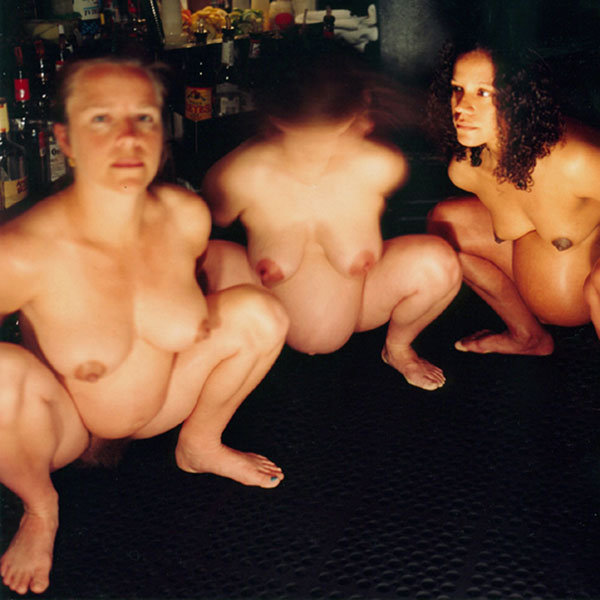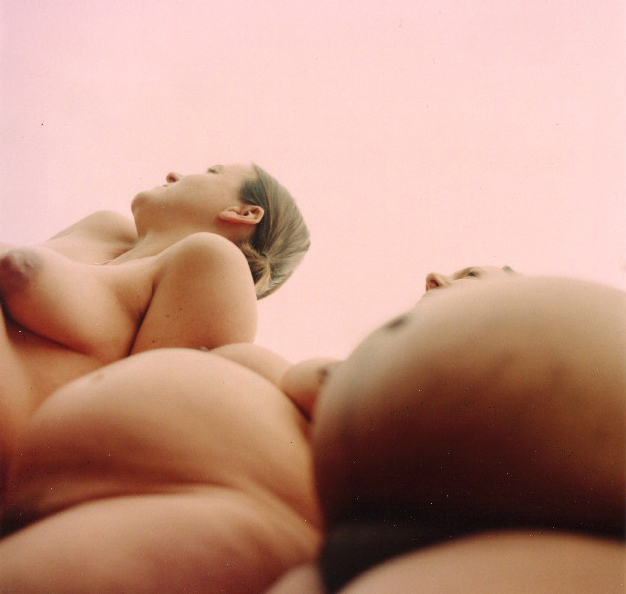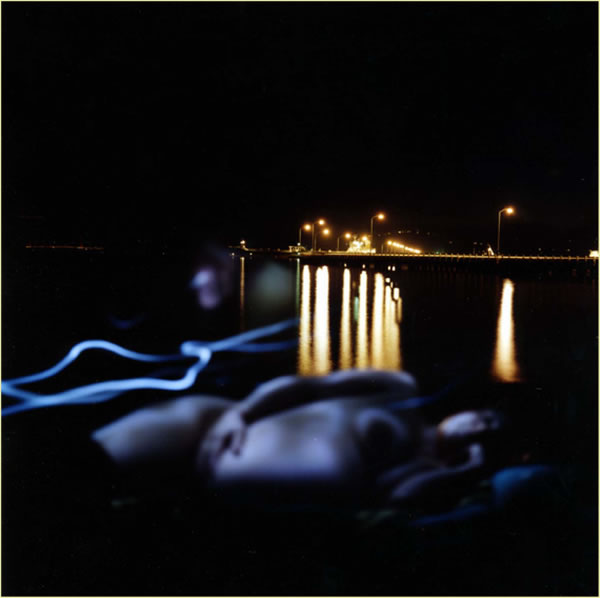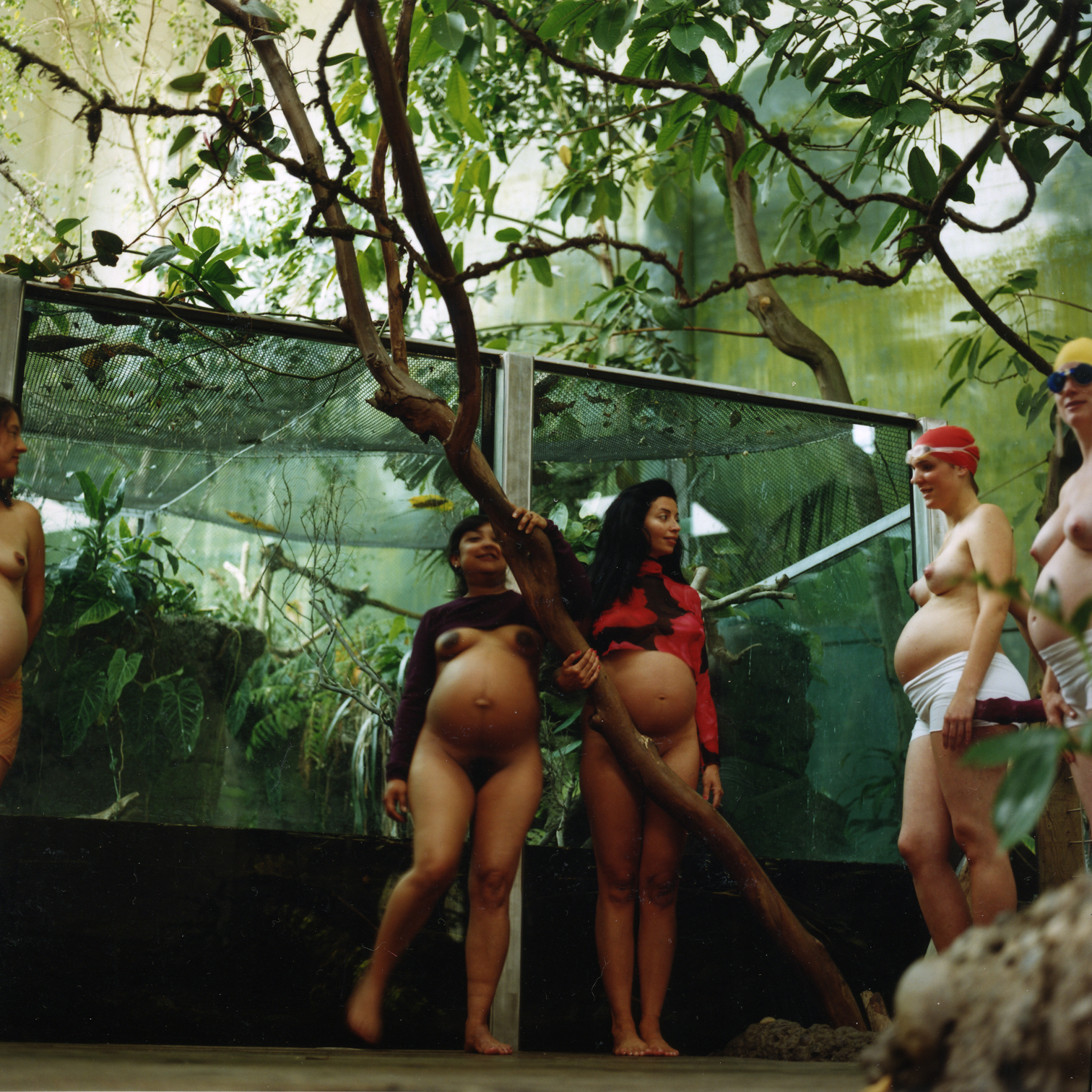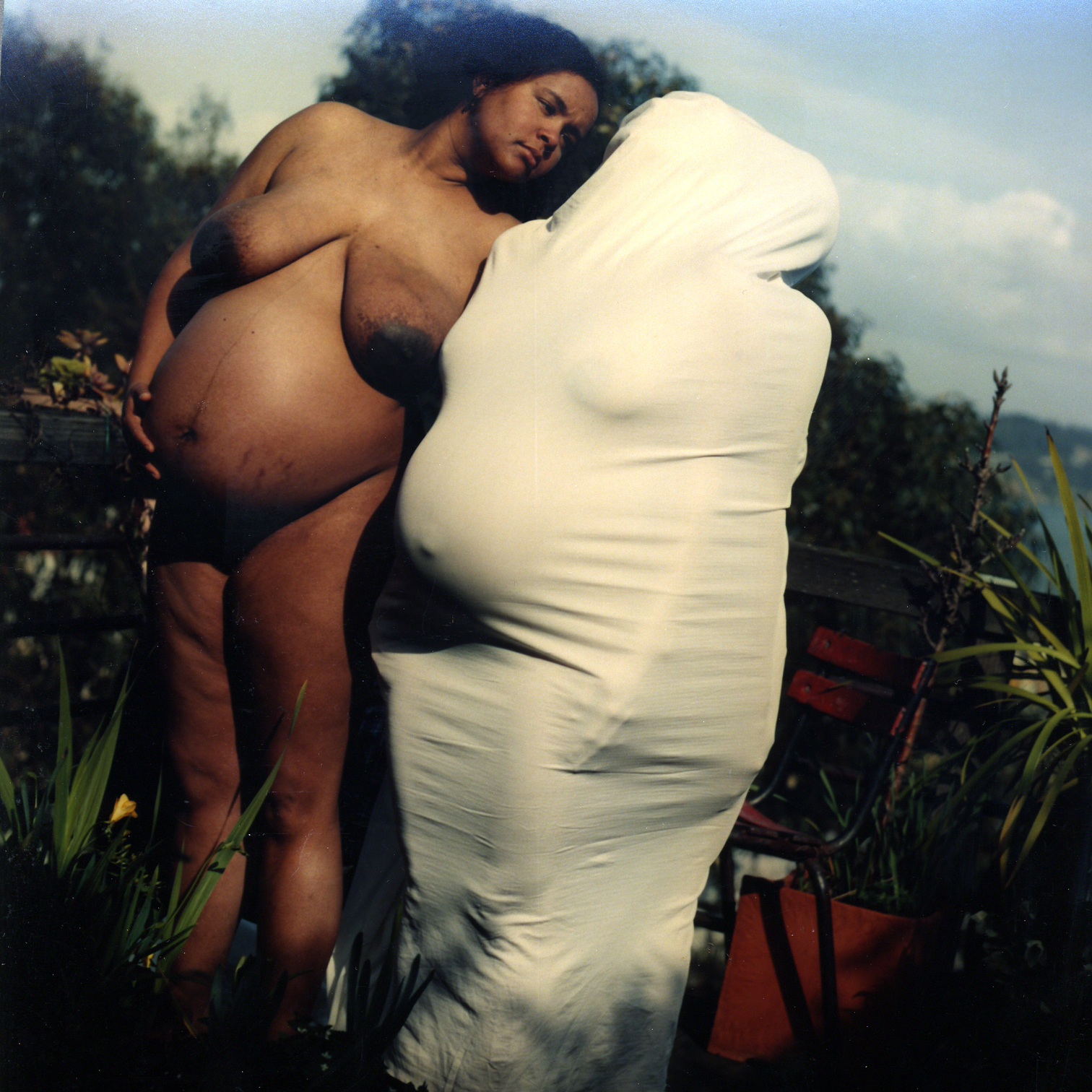Visualizing Pregnancy in Cara Judea Alhadeff’s “Gestation Project”
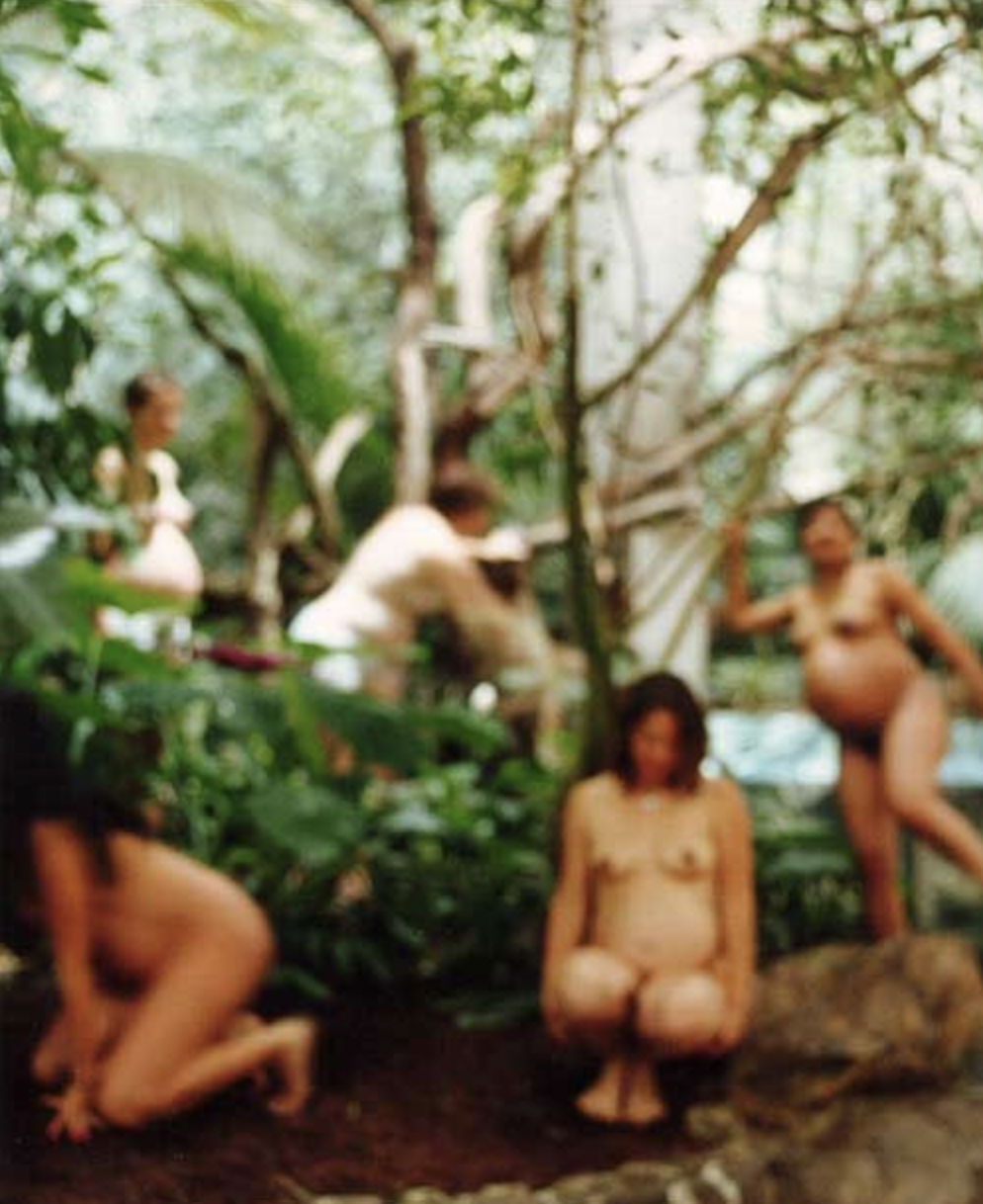
Tropical3, analog photography
South American Tropical Room, San Francisco Zoo
Copyright 2013, Cara Judea Alhadeff, All Rights reserved.
In her extensive 2013 photographic project “Gestation Project,” published by Mapping Maternal Subjectivities, Identities and Ethics (MaMSIE: Studies in the Maternal, Volume 5, Issue 2, Birbeck, University of London), North American Artist Cara Judea Alhadeff creates a colorful and sensual journey into pregnancy for the viewer.
The project, which comprises a large number of images devoted to the pregnant body, is a celebration both of gestation and of the liminal space in which women and pregnant people encounter when their bodies grow new human life. Through the images, viewers encounter pregnancy in all of its nakedness in a variety of spaces in San Francisco, including outdoor spaces, stores, shops, salons and theaters.
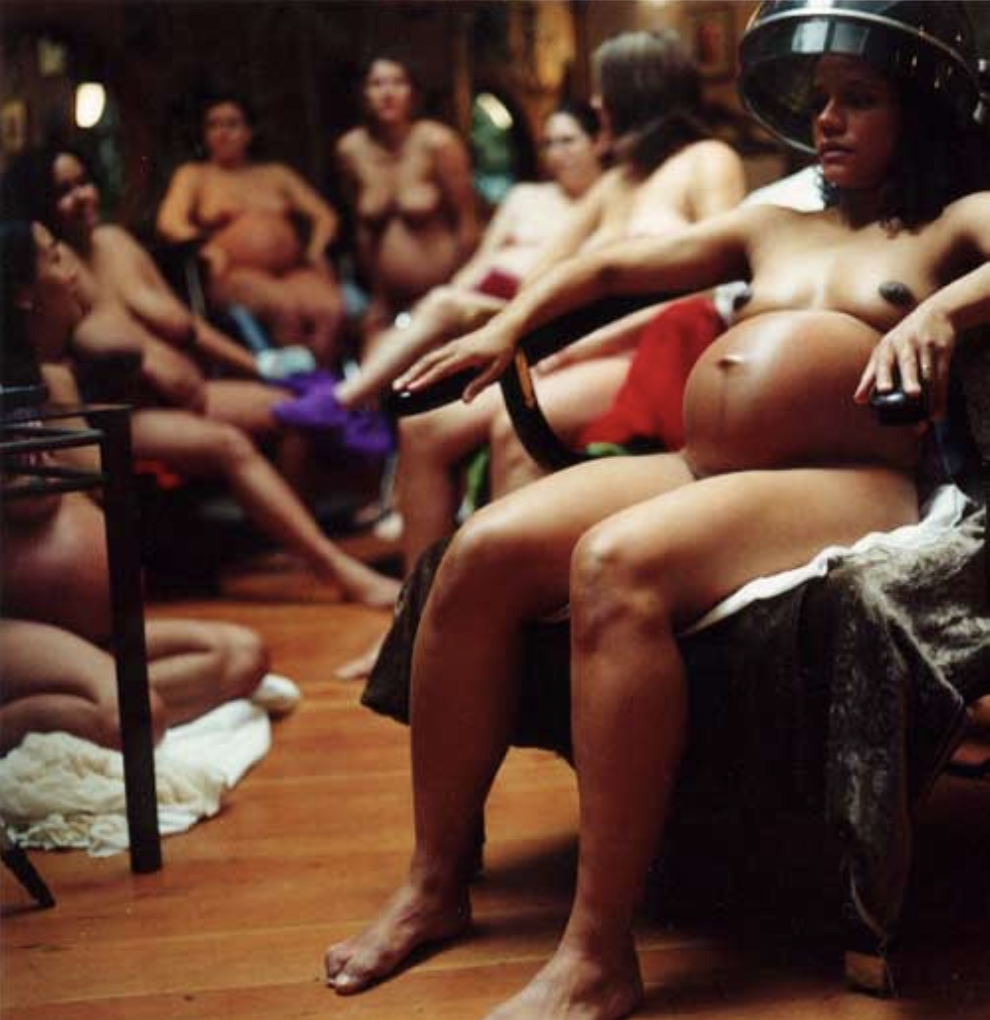
hair17, analog photography
Hair of the Gods Salon, San Francisco
Copyright 2013, Cara Judea Alhadeff, All Rights reserved.
As seen above in Tropical3 and hair17, Alhadeff’s Gestation Project represents pregnancy as a communal affair. In our contemporary world, women are often isolated in their pregnancies, and this isolation can bring worry or even fear to them as they approach birth, giving rise to a sense that they are on their own. Alhadeff’s way of presenting to the viewer a large number of bodies experiencing pregnancy together is helpful in reminding those who are pregnant that this rite of passage is shared by many and is not a solitary experience.
Alhadeff also presents pregnancy as powerful and erotic, defying modern depictions of the pregnant body as weak or incapable (see Harvard professor Ann Braude’s Radical Spirits: Spiritualism and Women’s Rights in Nineteenth-Century America [1991] for a discussion of how these depictions entered the cultural mindset in North America).
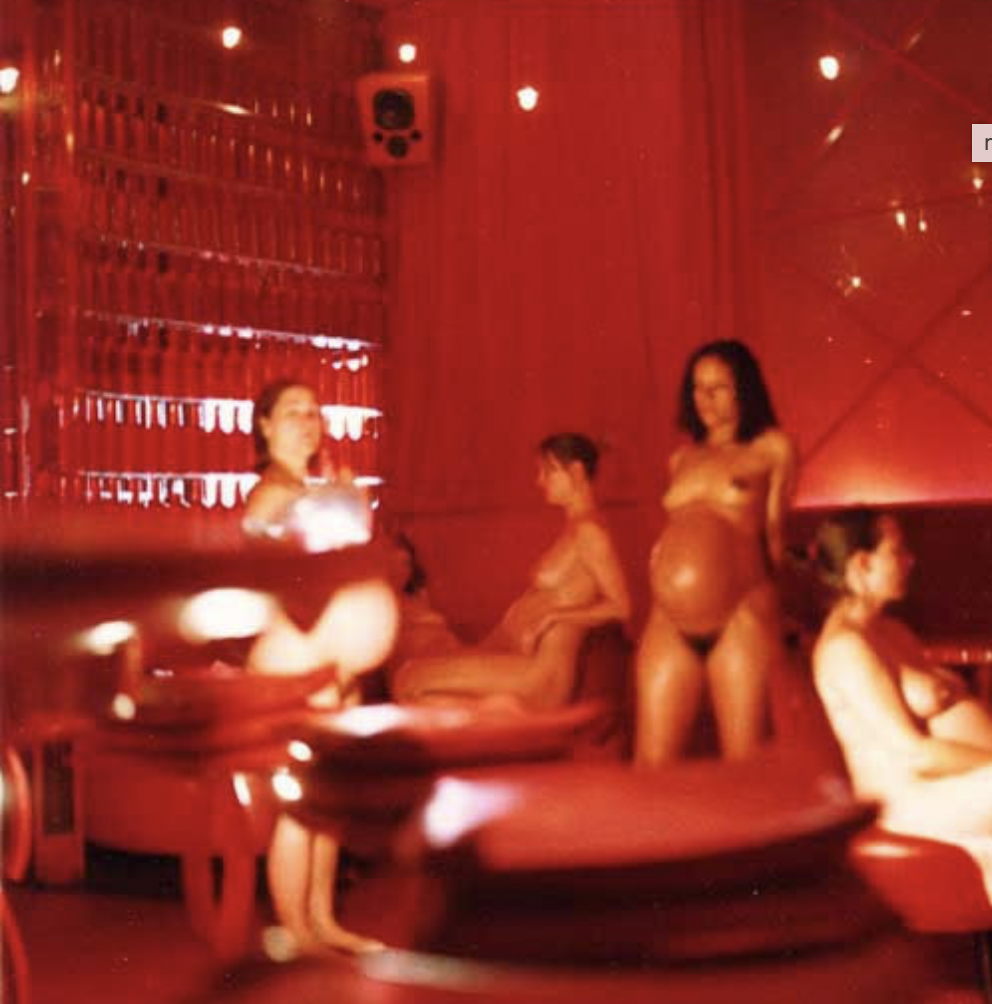
redroom8, analog photography
The Red Room Cocktail Lounge, San Francisco
Copyright 2013, Cara Judea Alhadeff, All Rights reserved.
In Alhadeff’s artist statement for the Gestation Project, the artist discusses both the multiple levels of sexuality and empowerment that are part of the pregnant body, as well as the unique ways in which the pregnant body communicates with society and the outside world:
The women’s pregnant bodies represent the simultaneity of inside and outside. Her private is undeniably public. Her body is raw and exposed and contained. Life within her is clearly visible from the outside. Because her corporeality cannot be concealed, the pregnant woman is exempt from societal constraints that obscure body awareness. The pregnant woman is the ideal subversive–challenging cultural norm in our society because her woman-ness is utterly present. She is sexual without objectification–the embodiment of sexual and corporeal empowerment.
She is the alchemist who embodies and transgresses notions of difference; opening the door for identification and disidenitification from others. By juxtaposing bodies and body fragments with organic and synthetic materials and environments, I play with the illusory distinctions between “them and us”: the familiar and the unfamiliar, what is supposedly comfortable and what puts us on edge. The pregnant woman, like the environments in which she is photographed, is both quotidian and surreal. Her body exudes with the excess of intimacy.
Alhadeff’s images empower those who are experiencing pregnancy and approaching labor and birth. Women can use her artwork for visualization purposes, both to imagine their own power in pregnancy and to understand that they are part of a larger community of pregnant women and people, all of whom are sharing in the journey towards birth.
Please see below for more images from Alhadeff’s Gestation Project. The pregnant women who participated in the project also contributed a number of testimonials. Please see the end of this post for these beautiful reflections on these women’s experiences modeling for the project.
Alhadeff also speaks and writes about the birth of her own son, Zazu, who was born unassisted at home on Alhadeff’s 40th birthday. The artist created a collaborative video piece on her pregnancy, the images of which may be seen here and here. Her son’s birth story could be helpful to others approaching birth as a rite of passage:
“Get on your hands and knees…” Suddenly, I could breathe. Everything snapped into alignment. As Kent straddled me, facing Jenna, he saw Zazu’s purple head emerge, then retract. Not only was the cord wrapped around his neck, one of his shoulders was caught behind my pubic bone. (It turns our that this was a case of shoulder dystocia. This happens in 1-2% of births; in hospitals most commonly dealt with through a c-section or in the worst case scenario, by breaking the infant’s collar bone; the brachial nerve can be damaged causing erbs palsy). In our tiny, plant and sun-filled bathroom (where Zazu had been conceived), our back-up doula, who had witnessed multiple births, but never delivered a baby before, channeled the divine, reached into me, unwrapped the cord and dislodged my baby’s shoulder. Moments later, she passed him to me through my legs and Zazu was in my arms. I had an unusually small amount of blood loss and no tearing, only abrasions. An hour or two later, I was ready to birth our placenta. It turned out there were two placentas—a succurient lobe! (We ate one raw and the other dehydrated). I cannot remember feeling any pain, or even discomfort during our birth—just an exquisite clarity.
Dr. Cara Judea Alhadeff, Professor of Transdisciplinary Ecological Leadership, has published dozens of books and articles on reproductive justice, sexuality and gender, critical philosophy, climate justice, art, and ethnic studies, including the critically-acclaimed Zazu Dreams: Between the Scarab and the Dung Beetle, A Cautionary Fable for the Anthropocene Era and Viscous Expectations: Justice, Vulnerability, The Ob-scene. Alhadeff’s theoretical and visual work is the subject of documentaries for international public television. She has been interviewed by The New York Times, San Francisco Chronicle, Pacifica Radio, NPR, and the New Art Examiner. Alongside Archbishop Desmond Tutu and Vandana Shiva, Alhadeff received the Random Kindness Community Resilience Leadership Award, 2020. Her work has been endorsed by Noam Chomsky, Bill McKibben, James E. Hansen, Paul Hawken, SHK-G, Eve Ensler, Alphonso Lingus, Avital Ronell, and Lucy Lippard among other activists, scholars, and artists. Alhadeff’s photographs/performance-videos have been defended by Freedom-of-Speech organizations (Electronic Freedom Foundation, artsave/People for the AmericanWay, and the ACLU), and are in private and public collections including MoMASalzburg and SanFrancisco MoMA. Former professor of Philosophy, Performance, and Pedagogy at UC Santa Cruz and Program Director for Jews Of The Earth, Alhadeff and her family live in their eco-art installation repurposed schoolbus where they perform and teach creative-zero-waste living, social permaculture, and cultural diversity. (carajudea.com / www.zazudreams.com)
To read Alhadeff’s article on Decolonizing the Womb, see here. The artist’s link to her Elsewhere Art Residency panel on Mother Artists is available here.
Testimonials from pregnant women models:
1.Cherie: What does it feel like to pose nude and pregnant with a bunch of other pregnant women? Strange, liberating, slightly erotic, rejuvenating, inspiring … it can help to catalyze the inner birth experience that goes on in preparation for the imminent outer one; I came to realize that not only was being pregnant a universal and generic experience, it was also a very individual and unique experience, and on both counts, one to be relished. Every woman’s body is unique and somehow different to every other woman’s body. The different possibilities of shape, color, and size, are infinite. Likewise, her mind is a very unique reflection of that Self that emanates through womanhood. That same simultaneous generic and individual experience also applies to the birth, and then to the mothering experience. I am one of millions of unique women who get pregnant and give birth in unique ways every year to millions of unique babies. Being clothed seems to conceal the magnitude of that reality. Our outer persona, ego or ‘little self’ (as Buddhists might describe it) is more concerned with how we might appear to others, and our preoccupation with fashion accentuates this state of mind. Being pregnant, and naked, amongst other naked pregnant women, invariably eliminates it, leaving one feeling more connected, more confident, and more excited about the experience to come.
2. Aileen: Prior to this experience, I had never thought about being photographed in the nude until I had become pregnant. Pregnancy is such a wonderful experience, one that I wanted to capture in print and the photo sessions that I was involved in allowed me to do that. When a woman becomes pregnant, her body morphs into something that is magical and wonderous! I look forward to sharing this experience with my son.
3. Charis: I found the photo shoots to be extremely cathartic. After many people making comments like “you’re huge, are you carrying twins”, in which they meant no harm, but nontheless hurt my feelings, I was able to transcend that. During the shoots I felt beautiful. They were raw and intimate, a perfect transition into motherhood. Labor is raw and intimate. Pregnancy is full of dichotomies, you’re scared yet somehow you know everything is fine, you have no direction, and yet somehow find your way. Everything I ever believed in, every preconceived notion I had flew out the door the minute Aidan was born. My ego melted, I surrendered. The photo shoots prepared me for that letting go, that stripping away of masks and letting the world see me as I truly am… So thank you Cara for the experience. Namaste, Charis
4. Sonia: Having photos taken of my nude and pregnant body was not just a memorable experience, but one that was empowering. I was at first tentative about the idea. I am no model. I don’t think I have a model body, a model look. And so it felt strange, taking my clothes off. I wasn’t sure I could do it, especially in front of all those people, the camera, the energetic air of a busy music store like Amoeba. But, after having done the shoots, I not only feel more comfortable with my body, I was better able to cope with being a pregnant woman, a woman who would soon have to shed my clothes in front of a room of doctors and nurses in a rather compromising state. In this way, the experience prepared me for labor. And, of course, it’s nice to be considered a prop of art.
5. Andrea: Well, standing in a room of naked pregnant women, surrounded by colors and textures, I felt like a living miracle and a living work of art . . . the experience was unique. I have never felt so beautifully female before nor since in my life. I thank you for the photos you gifted us for modeling, and even more I thank you for the experience and the memory.
6. Marisa: Odd feelings of being in a strange rather sharp environment of the hair salon with strange scary objects all around. Not the usual style conscious fashion orientated trendy salon. Even old fashioned barber chairs that I didn’t particularly want to be on with my full pregnant body and especially not naked. Appreciating the other women’s acceptance of the bizarre environment and their ability to have a good time-naked and semi-naked and Cara making it all seem very normal and acting like a kind and professional artist.
7. Anna: Modeling, nude and pregnant, for Cara was just what I needed for a pregnancy that required courage and a free spirit. I was going for a natural, vaginal delivery after two cesareans. Cara’s work with the Gestation Project, like birth, is a rich mix of vulnerability and introversion.
8. MJ: I used to be anonymous. I used to slip out of the office to play tennis in the middle of the day. I used to hold my book in front of my face when an acquaintance would walk down the train aisle, looking for a seat. I’ve never sung Karaoke, never danced on a bar, never shook my arm over my head when the performer asked for an audience volunteer. When my husband and I made the decision to get pregnant, I had no idea how exposed I was about to become. As my baby pushed the parameters of my body outwards, I felt myself breaking off from the mold of society. I was morphing into otherness, shedding layers of anonymity as I went. Pregnancy is open season. A protruding abdomen turns women into targets for limitless stares, commentary, and uninvited touching. As living paradoxes, we are at once mysterious and entirely understood. Our private space has become unavoidably public. Our bodies isolate us from others, and yet, win us acceptance into the oldest club in history. Like Hester Prynne, we wear our plight across our fronts. And people notice. But not just strangers. It was the people I worked with everyday who reacted most curiously to my scarlet letter of abundance. Despite our years together in conference rooms and happy hours, I became one thing to these people pregnant. If I was eating yogurt and banana at my desk, I was having a pregnancy craving. If I was walking down the hall well then I must be headed for the bathroom. I didn’t know what I wanted more, to disavow these people of what they thought they knew of me, or simply go back to being anonymous. This is precisely why my participation in Cara Judea Alhadeff’s photoshoots was such an important part of my pregnancy. Not just because I was able to spend the afternoon with other people bearing the same load to carry. My prenatal yoga and natural childbirth classes afforded me that. Being a part of Cara’s vision meant finally exposing myself as opposed to being exposed, removing the thin veils of clothing that stood between the outside world and my inner world. I was ready to reclaim the parts of myself that had transgressed into public domain. I stood in an African Goddess hair salon naked, chilly, and uncomfortable with a desire to say to the camera, Here. Is this what you’ve been wanting to see? Take your look then. Stare at me. I am swollen. I’ve gone brown with ripeness. My nipples have spread and darkened like mud. My legs have veins that show blue through skin. When you see me on the street, you see none of this. To you, I represent so much more than I want to. Shooting pregnant women in a hair salon, and later a zoo, a nightclub, a record store, and an empty auditorium exploded the expected, and what fell into place was a narrative of maternal magical realism. How else can you capture something that is eternally natural, and yet feels like a logistical impossibility? Religiously chaste and yet erotically sensual? Communal and yet isolating? Symmetrical y perfect and yet grotesque? How can you display the love one feels for her unborn child, the strain she feels from carrying him, and the daunting thrill she has of pushing him out? How can a photographic exhibit tell the story of the emotional duality and the spiraling contradictions that make up this incredibly unique and ephemeral chunk of life? Cara turned the image of expectancy into hyperbole. She took what we think we know, what we’ve all seen a million times before, and propelled it out of our comfort zone. She colonized a new realm characterized by playful swaps. Compositionally, Cara shows us a world of intimacy and of distance, of fullness and wonder. We are solid in mass and in number and yet at times, quite uncertain. We manage to exude a peacefulness and sense of belonging despite the incongruity of being naked in public settings. From the perspective of model, it seemed that Cara approached these shoots with very little expectation. She never knew how many of us were going to show up (one model had the very permissive excuse of having gone into labor during one of Cara’ shoots); she never knew the level of intimacy she could attempt to establish among total strangers; and there was always the variable of sensitive body issues. One model agreed to pose nude as long as her body and her face were not in the same shot. Without so much as a furrowed brow, Cara accepted this woman’s personal limitation and shot accordingly. It is this acceptance, openness, freedom, and whimsy so evident in Cara’s work. By the end of the afternoon incidentally, the modest woman seemed to have lost her inhibition and appeared before the camera lens without restraint. Those shoots were a process of shedding inhibition. Letting go when you’re holding so much was an incredibly cathartic exercise and one I look back on with fondness and warmth. We entered record stores and hotel lobbies feeling out of place in our own uncovered skin, and midway through the shoot, we were all usually remarking on how unbelievably normal it had become to be naked with each other. Yeah yeah, your belly button has popped out like a meat thermometer, and your abdomen is rippled with stretch marks, and my ass is fat, and your ankles have blown up, and here we all are naked at the zoo and I’ve never felt so at ease with a group of people in all nine months of my pregnancy. In fact, at one point in the hair salon shoot, a client had to get rinsed in the room where we were posing. Cara gave us a minute to cover up, but by that point in the day, none of us really felt the need to scramble for clothing for the five or ten minute interlude. Interestingly enough, it was the fully clothed pair, the woman client and her male stylist who seemed out of place. This was an environment turned on its head. And the photos bear witness to the invented reality. Tim O’Brien wrote, in his contemporary collection of short stories entitled, The Things They Carried, that sometimes story truth is truer than happening truth? When I look at Cara’s photos of pregnant women horizontal in a hair salon, perched on barstools, roaming the aisles of a record shop, milling around a lion’s den, I think, yes, that’s what it was like to be pregnant. Even though none of those people would actually be doing any of those things in a conventional reality, Cara’s work illuminates a very real truth about the complexities of pregnancy. As the client lay back for her rinse, and the stylist kept to his task, I grabbed a fashion magazine and sank into a swivel chair. I was one of a dozen naked pregnant women in a room filled with painted masks and Aboriginal woodcarvings. I flipped glossy magazine pages and relished the moment of feeling once again unremarkable.
9. Anne Francis: I enjoyed the experience. It was fun and such a pleasure to hang out with other pregnant women while the project unfolded around us. And it really brought home how life is art; and art is life. Life in our bellies, in our veins, in the capturing of a moment on film. You know?
10. Alexandra: I found the experience physically liberating. As your body expands in ways you never expected, you are constantly trying to determine what clothing looks nice, potentially how to hide some other new lumps? etc. But while modeling amongst other pregnant women, I strangely found myself feeling at ease with my body as a whole; as a whole it was representing pregnancy, not just the stomach, and as a whole it represented a beautiful process. Of course, the juxtaposition against the lions certainly helped lessen my focus on my body and its flaws.
11. Julia: What I loved most about being in the gestation project was being and communicating with the other pregnant women, naked, in the space. Pregnancy is such a unique, sacred, special time, with a huge learning curve for first timers. Meeting to prepare for the shots seemed to honor that time, step away from our busy lives. Posing with out close brought an instant/false intimacy allowing each of us to really take a look at the unique shapes of the pregnant body in different places in a city, have a conversation, or ask a question to a second time mom about something that you had had your mind on and kept forgetting to ask someone about…all with out embarrassment. My body changed so dramatically that it was sometimes hard to remember that it was really happening and seeing the others in similar situations, not just through the layering of clothes was comforting, and bonding. I loved it and I enjoy running into some of those people around town now.
12. Devra: Modeling with the puppets while pregnant represented an image of women’s cycle of Life – there we were, naked and abundant, surrounded by larger than life images of women in mourning. We were on the precipice of bringing new life into the world – almost in defiance of the fact that women throughout the world loose their children to war, tyranny, hunger and poverty every day.
13. Maria: I never felt so full of life and energy than when I was pregnant. I loved by changing body and I wanted to preserve the memory of my body in this state. A friend offered to take some semi nude or nude photos of me or go with me to make a body cast. Her photo idea was to do something like Demi Moore did on the cover of some magazine years ago. Neither option sounded appealing. I guess I felt embarrased to pose for my friend. The irony is that I felt comfortable posing in a strange environment with a bunch of strangers and for a complete stranger.
14. Monique: I wasn’t quite sure what it was going to happen when I first walked into the hair salon. It sort of felt like going into a girls locker room for the first time with everyone checking each other out politely but with deep curiosity and then as we began to relax we could start to ask all kinds of questions that only pertain to pregnant people. It was so beautiful to see bellies of all shapes and sizes and to know that we were all safely carrying around a new generation of people in them. Then, to see the pictures months after having the babies was slightly strange. The people in them looked sort of foreign. We all looked different with our empty tummies. It was a great experience. Thank you.
15.Yami: I am an artist myself and clearly recognize Cara’s passion for the subconscious, impossible, and surreal living art. Cara’s easiness and artistic vision completely blew my mind. My expectations from the first photo shooting were thrown out of the window. I had prepared myself for an average experience, some traditional and disconnected belly shots…Instead, I found myself deeply immersed in this artistic, expressive, fulfilling and abstract art project. I felt connected to the awkwardness of the setting, the boxing gloves in our arms, the unexpected goggles, the fabrics covering our faces, the different bodies, ethnicities?and all empowering pregnant women It was surreal. I became an open book giving a story, showing a feeling, creating an image, recreating a human concept, being a restless, strong, weak, unexpected , happy pregnant woman? Modeling for Cara was an intrinsic and magical experience; I truly look forward to sharing my pictures with my daughter, Xara Luna.
16. Stephanie: The mommas’ bodies are beautiful, poised for the picture, but the babies are the ones most present. Surrounded by these bellies, butts and boobs, I found comfort in my baby’s company with the other growing babies.
17. Hankie: Modeling for Cara was a unique experience that gently pushed me outside my comfort zone and opened a door to nonconformity and free __expression. I soon found myself relaxed, content, and bonding with the other mothers-to-be in a special way.
18. Nicole: Pregnancy is an absolute amazing and beautiful progression and pregnant woman are radiant. I totally enjoyed being pregnant and watching my body go through this metamorphosis. As I enjoy and appreciate seeing other pregnant woman. I think society makes women self conscious and woman to often want to cover up when they are pregnant and hide there bodies, as if they are ashamed. I think this is a time when you should be proud to have so many curves and feel free to let it show. Being a part of this photography project was very invigorating and liberating. It helped my let go of my inhibitions and helped me feel free. There was something almost primitive about it. Being able to share this with all the other woman was a extraordinary experience and totally refreshing. Thanks for such a great experience.
19. Adela: Pregnant women look at their body very often. We spend many hours in the mirror looking at hour belly, our breasts, our face… Sometimes I hate the changes in my body because they are the physical manifestation of how much control I am losing in my own life. Nobody looks at a pregnant woman; they look and see a future mother, a baby growing, a metaphor for abundance. I liked modeling for you because I felt that you were focusing on the amazing volumes and combinations of our bodies, but not necessarily because they represented any mistery of nature reproducing itself or any ideal of beauty. Personally, I always welcome the chance of doing something out of the ordinary, and leaving for a moment my very petit-boeurgeoise life.
